|
Artist Jen Lewin recently revealed her concept for the iconic artwork that will light up both the ticketing and baggage claim levels of Terminal 1-Lindbergh.
The Metropolitan Airports Commission (MAC) along with the Airport Foundation MSP and Arts@MSP, welcomed Lewin to Minneapolis-St. Paul International Airport (MSP) earlier this month to present her concept for the interactive, public artwork.
“We couldn’t be more pleased with the concept Jen has created for our airport,” said Brian Ryks, MAC Executive Director and CEO. “It’s going to be a stunning piece of artwork and we invite everyone to come out and interact with it once it’s installed.”
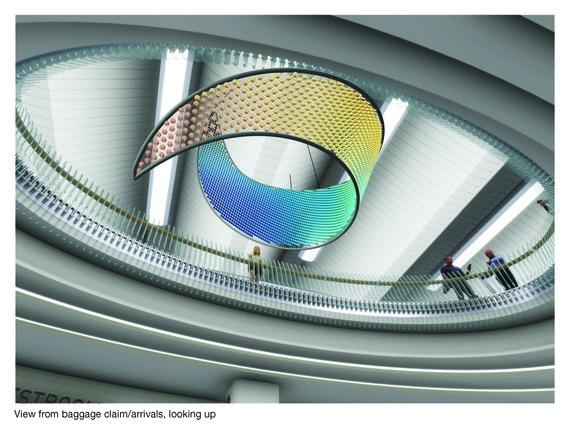 The custom-designed piece will be called Aurora, a hovering wisp of glass and metal, floating above and below the ticketing level floor opening.
Below the Aurora, embedded in the floor on the baggage claim level, will be an interactive cluster of reflective glass platforms, the forms of which generally represent the waters of Minnesota and which are loosely derived from several lakes in the Minneapolis-Saint Paul area.
Standing in the "lakes" will trigger swirling light and interactive color.
More information is available at this page on MSP's website. The piece will be installed in 2020.
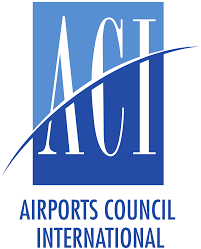 America's airports are major economic engines and play a valuable role in job creation and economic growth, a recent report found.
A study by Airports Council International-North America analyzed the contributions of 493 commercial airports, including airports in Minnesota.
The study found that the airports contribute more than 7 percent to the nation's gross domestic product, support a total of 11.5 million jobs and create a total payroll of $428 billion.
|
MSP recently hosted its eighth annual IROPs (irregular operations) workshop, bringing in more than 50 attendees from the regional aviation community.
Irregular operations include things such as passengers stranded at an airport due to weather, special events that disrupt air traffic, or other incidents that may impact travelers.
Topics covered at the conference included a recap of Super Bowl 52 operations at MSP; planning for the NCAA Final Four taking place in April, 2018; updates from government agencies and how to use social media for IROPs events involved in air transportation.
“We received a lot of positive feedback about the topics covered at the conference,” said Sara Freese, assistant director of MSP operations/field maintenance and airside operations, who helped plan the conference. “Many attendees said there was a lot of good information provided and they are excited for the next steps in building stronger regional collaboration.”
Attendees included staff from the TSA, FAA, Customs and Border Patrol, airlines and 14 regional airports.
(Editor’s note: Following is the 10th and final story in a series chronicling the history of the Metropolitan Airports Commission, which is marking its 75th anniversary this year. Earlier stories in the series are found on this website.)
Signs of improvement for the airline industry
As the Metropolitan Airports Commission entered the 2010s, the economy began to bounce back and the number of travelers at MSP started to rise. It also became clear that MSP would remain one of the nation’s largest hub airports, following Delta Air Lines’ acquisition of Northwest Airlines.
Still, passenger numbers took some time to recover from the deep recession of 2007 and onward.
Annual passenger traffic at MSP stayed below 34 million through 2013, but showed larger gains starting in 2014 and beyond.
As the recovery gained momentum, additional capital improvements to MSP ramped up as well.
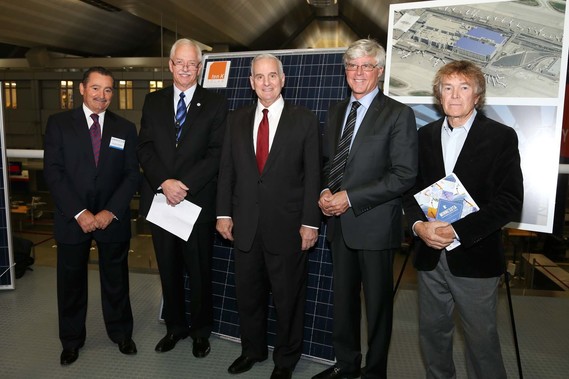 At the 2014 announcement of MSP's solar array installation (l-r): George Sakellaris, CEO of Ameresco; Jeff Hamiel, CEO of the MAC; Gov. Mark Dayton; Mark Andrew, president of GreenMark; Will Steger, noted polar explorer.
Capital improvements continue
The largest structure-mounted solar power installation was announced in 2014, with the first units constructed atop parking ramps at Terminal 1. Minnesota Gov. Mark Dayton, along with explorer and climate activist Will Steger, were on hand for the announcement in October 2014, with Jeff Hamiel, the MAC’s CEO and executive director, and representatives from Ameresco, the firm that developed and operates the system.
The two solar arrays would offer 3 megawatts of power and herald the airport’s new emphasis on sustainable operations.
A second, 1.3 megawatt solar generation facility was commissioned atop two Terminal 2 parking ramps soon after.
The Quick Ride Ramp, formerly used by Delta Air Lines employees, opened in 2015 with 1,400 spots for value-minded travelers, just in time for spring break. And the two-story ramp’s debut was well-timed, as the first day that it was open the ramps at Terminal 1 filled with spring break traffic and cars were diverted to the new facility.
In the fall of 2015, MSP unveiled a new outdoor aircraft viewing area on the west side of the airfield, at the end of Cargo Road. The new site includes parking, picnic tables and benches, and remains a popular destination for plane spotters and other aviation enthusiasts.
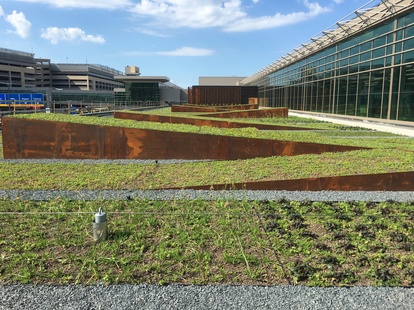 Pictured: The green roof on Terminal 2, completed in 2016.
Now arriving at MSP: Service from new airlines and a plan for a hotel
At Terminal 2, the arrival of Southwest Airlines in 2009 marked a period of new carriers expanding operations at MSP to destinations around the country.
Though Southwest initiated service with flights only to Chicago Midway, within months it added service to St. Louis and Kansas City, increasing competition on those routes and lowering airfares. Today Southwest serves 15 non-stop destinations.
Spirit Airlines began service at MSP in the spring of 2012, offering an a la carte pricing system for flights to Chicago and Las Vegas. Today, Spirit flies to 13 non-stop destinations from MSP and operates out of Terminal 1.
The Spirit announcement was one of several for MSP as the airline industry continued to see business improvements, and demand for airport gate space increased.
In the spring of 2013, Air France launched seasonal service to Paris, strengthening MSP’s international offerings. Also in 2013, Condor airlines announced that it would start offering seasonal service from MSP to Frankfort, Germany in 2014.
In late 2014, the MAC announced that it was seeking proposals for an airport hotel, which would be located along the entrance road to Terminal 1. The hotel had been one of the priorities in 2010 when the MAC published its 2030 Long-Term Comprehensive Plan.
|
Hamiel era ends; Ryks begins
In September of 2015, long-time MAC CEO Jeff Hamiel announced his pending retirement. Hamiel had joined the MAC in 1977 and became CEO in 1985.
His 30 years in the top job saw the number of passengers served at MSP increase more than four-fold. His tenure also included handling the effects of the 9/11 terrorist attacks and the security changes that followed, the dual-track study that led to a $3 billion expansion of MSP, and Northwest Airline’s bankruptcy and merger with Delta.
The MAC hired a recruiting firm to conduct a national search for Hamiel’s replacement, and in March of 2016, a MAC committee recommended Brian Ryks, the head of the Grand Rapids, Mich. Airport, to take the helm. The MAC board approved the hire that same month.
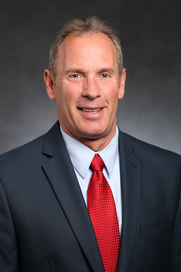 A Lakeville native, Ryks (pictured) had worked for the MAC from 1986 to 1990 in the noise programs office, and had led four airports, including those in Duluth and St. Cloud, prior to his return to MSP and the MAC. He started his new position in May, 2016.
In the two-and-a-half years since, the MAC has continued to make improvements to the customer experience and reap the rewards.
In 2016, Cintas Corp. named MSP the latest winner of America’s Best Bathroom. The award recognized the ongoing remodeling, renovation and original mosaic art that’s part of MSP’s larger capital improvements plan. The finalists were selected by thousands of public votes online, and all public restrooms were eligible, not just those at airports.
In the fall of 2016, work was completed on four new gates at Terminal 2-Humphrey, along with a lactation room for nursing mothers and an indoor pet-relief area for service animals. The additional space helped serve flights added by Southwest and Sun Country. The addition also included MSP’s first green roof, using plantings to help minimize rainwater runoff.
In 2017, KLM Airlines began offering seasonal service to Amsterdam out of MSP. The route from KLM, a partner with Delta for North Atlantic service, offers travelers an additional way to get to Europe and a large number of connections to international destinations.
Both in 2017 and 2018, MSP was named the best airport in North America in its size category, which is 25 million to 40 million. The award is presented by Airports Council International (ACI), and the ratings are based on surveys of passengers at the airport on their day of travel, measuring things such as wait times for security lines, restroom cleanliness, dining options and customer service.
Also in 2017, MSP broke its 2005 record for numbers of passengers served in a year, as 38 million passed through the airport.
In 2017 and 2018, MSP also received the Most Efficient Airport Award for its size category from the Air Transportation Research Society.
|
 The InterContinental Hotel arrives at MSP
The MAC’s plan to bring a hotel to MSP led to an agreement with Graves Hospitality to bring an InterContinental Hotel to the campus. The luxury hotel opened last summer, with 291 rooms, a skyway connection to Concourse C, two restaurants, a bar and a spa. The hotel’s ballroom space has already hosted several large events, including the 2018 State of the Airport luncheon and a visit by the President of the United States.
In addition to a hotel, the MAC had long sought to land JetBlue, one of the last major domestic carriers without a presence at MSP. That idea became a reality this past spring as JetBlue started direct service to Boston, operating out of Terminal 2. The ceremony for the inaugural flight included a drum-and-fife corps, a planeload of passengers from the East Coast and an epic layer cake decorated with scenes from Boston.
Throughout the last decade, the MAC also augmented its efforts to operate sustainably. In 2005, the MAC – along with the FAA, Delta Air Lines and other partners – began collaborating on a program known as optimized profile descent. Essentially, the program involves a new way for aircraft to approach MSP on a continuous slope, without leveling off at various altitudes, which requires engine acceleration and more fuel-burn.
The move significantly reduced the airport’s carbon footprint and lowered the airline’s fuel costs.
Between the summers of 2016 and 2017, 50 brand new or redesigned concessions opened at MSP, following a major rebid for the airport’s restaurants and shops. The refresh of concession space brought new national and local restaurants and shops, giving travelers abundant choices.
|
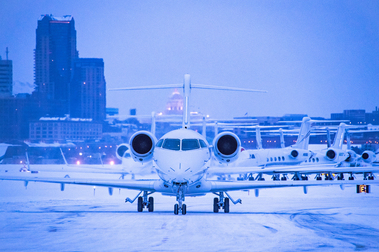 The MAC worked overtime to welcome visitors to the Twin Cities for Super Bowl 52 in February of 2018, as passenger volumes led to the busiest day in MSP’s history.
Pictured: Private planes at the St. Paul Downtown Airport for Super Bowl 52.
On the Monday after the game, a total of 60,455 people came through airport security checkpoints, breaking the previous record of 47,000 set during spring break of 2017. The TSA augmented its staff, brought in explosives detection canine teams to help speed the security checkpoints, and the day went off without a hitch.
At the MAC’s reliever airports and at MSP, crews worked to make room for an estimated 1,100 private planes that flew in and out for the game.
|
Beyond the first 75 years; What’s ahead for the MAC
As the MAC plans for upcoming events, there’s no shortage of major milestones ahead.
The 50 new concessions that opened recently were only the beginning.
A new food court on the mall at Terminal 1 is under construction and will open in 2019, part of a total of 30 new restaurants opening at MSP in 2018 and 2019. This second round of new offerings will include People’s Organic, PinKU, Hi-Lo Diner and the recently opened Blue Door Pub.
In the airline service category, Aer Lingus – an Irish airline – announced recently that it will start non-stop service to Dublin in the summer of 2019.
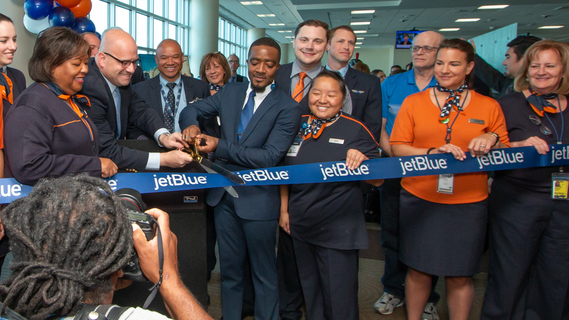 At the arrival of JetBlue's inagural flight to MSP in May, 2018.
Delta Air Lines also announced that it will begin service to Seoul, South Korea in 2019 and is currently working with the government of the U.S. and China to offer direct flights to Shanghai starting in 2020, which would mark the first non-stop route ever from Minnesota to China.
Concept drawings for an iconic art piece were recently unveiled, to span Terminal 1’s ticketing and bag claim lobbies. The artwork will be in place by 2020. The artwork is one piece of a major renovation and redesign of Terminal 1’s ticketing and baggage claim levels that is ongoing and will transform the customer experience.
The airport’s arts program is now benefitting from a “Percent for the Arts” policy that the MAC board adopted, which includes money for the arts in each year’s capital improvements program.
Construction of the new, 5,000-space Silver parking ramp is also making progress at Terminal 1. The ramp will open in 2020, alleviating parking congestion that occasionally forces airport customers to park in ramps elsewhere on the MSP campus.
MSP International and the Twin Cities will also be on the national radar again in the spring of 2019, when the NCAA Men’s Final Four basketball tournament is held in Minneapolis.
Looking back at the MAC’s origins 75 years ago, its founders wanted MSP to become a gateway to the world and bring economic development to the Twin Cities region.
Today, MSP offers direct flights to 166 destinations – 137 domestic and 29 international – and serves 38 million passengers annually. The airport’s economic impact on the region is approaching $16 billion – numbers never imagined in 1943.
Sources: MAC archive material; Minneapolis Star Tribune.
Board Meetings
Business Opportunities
Career Opportunities
General Aviation Airport Information
InterContinental Hotel
MSP Aircraft Noise Information
MSP Airport
|